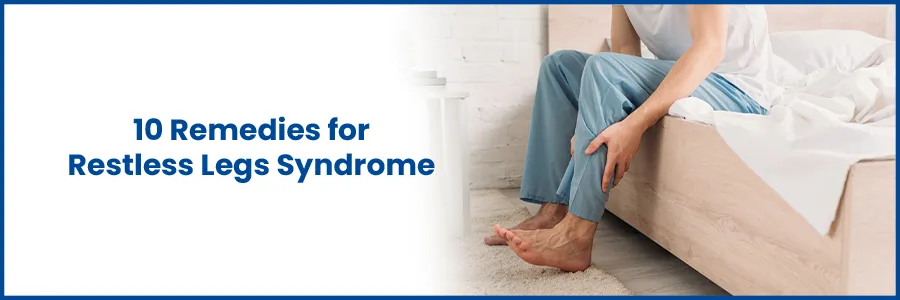Categories
- Cardiology 84
- Dermatology 45
- Endocrinology 33
- ENT 16
- Fertility 190
- Gastroenterology 78
- General-Medicine 81
- Gynecology 80
- Hematology 19
- Infectious-Diseases 33
- Neurology 52
- Oncology 34
- Ophthalmology 23
- Orthopedics 69
- Pediatrics 31
- Procedure 23
- Public-Health 144
- Pulmonology 59
- Radiology 8
- Urology 68
- Wellness 161
- Woman-and-child 77

Effective Remedies for Restless Legs Syndrome
RLS, or Willis-Ekbom Disease, is a neurological disorder causing distressing sensations in the legs, leading to an uncontrollable urge to move them. This condition can disrupt sleep, make daily tasks difficult, and decrease the quality of life.
While there is no single cure for RLS, various home remedies and lifestyle changes can help relieve its symptoms. Here are 10 of the most effective strategies for managing this syndrome.
Secure your health with a second opinion. Make informed decisions and book your appointment today!
Get A Second OpinionRegular Exercise
Regular physical activity can greatly reduce the severity of RLS symptoms. Activities like walking, swimming, yoga, and stretching help improve circulation and promote relaxation. This is considered one of the best remedies for restless leg syndrome.
Warm Baths
Soaking your legs in a warm bath before 10 Effective Remedies for Restless Legs Syndrometime can help relax the muscles and ease the discomfort associated with RLS. Adding Epsom salts or aromatic scents like lavender can help to improve the relaxing impact. This is a popular home remedy for restless leg syndrome.
Massage
Gentle massage can help relax the muscles and improve blood flow, providing relief from RLS symptoms. Focus on massaging the legs and calves using circular motions and light pressure. This method can be part of a homoeopathic remedy for restless leg syndrome approach.
Iron Supplements
Low iron levels are often associated with RLS. Find out if you have it by consulting a healthcare professional about an iron deficiency, and if needed, consider taking iron supplements under their guidance.
Dietary Adjustments
Certain dietary changes can help manage RLS. Avoid consuming caffeine, nicotine, and alcohol, especially in the evening, as they can worsen symptoms. Incorporate foods rich in iron, magnesium, and folate into your diet. For pregnant women, these adjustments can serve as restless leg syndrome pregnancy home remedies.
Establish a Sleep Routine
Maintaining a consistent sleep schedule can regulate your body's internal clock and improve sleep quality. Create a calming 10 Effective Remedies for Restless Legs Syndrometime routine that includes relaxation techniques, such as deep breathing or meditation.
Compression Garments
Graduated compression stockings or sleeves can improve circulation and reduce sensations of discomfort in the legs. Consult the doctor to find the right compression level for your needs.
Heat and Cold Therapy
Applying heat or cold packs to your legs can help alleviate RLS symptoms. Experiment with both methods to find out which one provides you with more relief.
Medication
In severe cases, a doctor may recommend medication to manage RLS symptoms. Common options include dopamine agonists, opioids, and anticonvulsants. However, these medications should be prescri10 Effective Remedies for Restless Legs Syndrome and monitored by the doctor due to their potential side effects.
Mind-Body Techniques
Practices like yoga, tai chi, and mindfulness meditation can enhance stress reduction and general well-being. These techniques can indirectly alleviate RLS symptoms by promoting relaxation and better sleep.
Ready to take control of your health journey? Book your appointment now and start your path towards wellness today!
Book an AppointmentConclusion
Dealing with Restless Legs Syndrome can be challenging, but with the right strategies, you can manage its symptoms and improve your quality of life. Remember, what works for one person may not work for another, so it's important to try different remedies and lifestyle changes to find what suits you best.
If your symptoms persist or worsen, don't hesitate to seek guidance from a healthcare professional. By taking a proactive approach and making the necessary adjustments, you can minimize the impact of RLS on your daily life and enjoy better sleep and well-being.
Frequently Asked Questions
Restless Leg Syndrome (RLS) is a neurological disorder characterized by an uncontrollable urge to move the legs, often accompanied by uncomfortable sensations. These sensations are typically worse at night or during periods of rest, leading to difficulties in falling or staying asleep.
Certain vitamins and minerals may help alleviate symptoms of RLS. These include iron, as iron deficiency is often linked to RLS, as well as folate, magnesium, and vitamin D. It's important to consult with a healthcare provider before taking supplements to determine the appropriate dosage and necessity.
Treatment for RLS often includes lifestyle changes, such as establishing a regular sleep routine, reducing caffeine and alcohol intake, and engaging in moderate exercise. Medical treatments may involve iron supplements if deficiency is present, and medications like dopamine agonists, anticonvulsants, or benzodiazepines. It's important to work with a healthcare provider to determine the best treatment plan.
Yes, a warm bath before 10 Effective Remedies for Restless Legs Syndrome can help relieve RLS symptoms. Warm baths can relax the muscles and improve circulation, which may reduce the uncomfortable sensations associated with RLS and promote better sleep.
It is important to seek medical advice for RLS, especially if the symptoms are severe, disrupt sleep, or affect daily activities. A healthcare provider can diagnose underlying causes, recommend appropriate treatments, and help manage the condition effectively.

Categories
- Cardiology 84
- Dermatology 45
- Endocrinology 33
- ENT 16
- Fertility 190
- Gastroenterology 78
- General-Medicine 81
- General 6
- Gynecology 80
- Hematology 19
- Infectious-Diseases 33
- Neurology 52
- Oncology 34
- Ophthalmology 23
- Orthopedics 69
- Pediatrics 31
- Procedure 23
- Public-Health 144
- Pulmonology 59
- Radiology 8
- Urology 68
- Wellness 161
- Woman-and-child 77